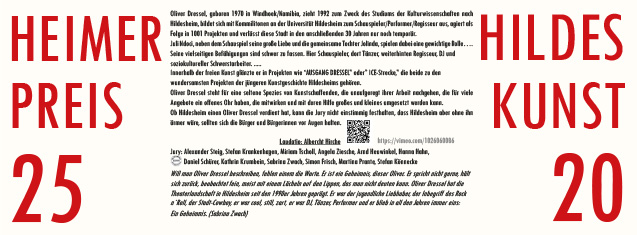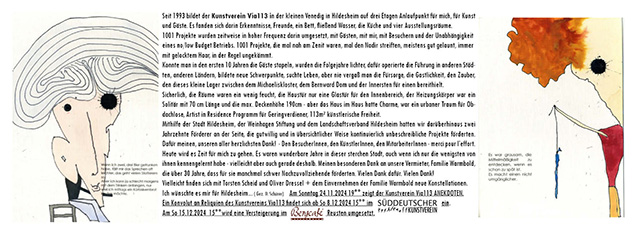


From the project RELIQUIEN EINES ART ASSOCIATION
HILDESHEIMER ART PRIZE 2025
Oliver Dressel, born in 1970 in Windhoek/Namibia, moved to Hildesheim in 1992 to study cultural studies, trained with fellow students at the University of Hildesheim to become an actor/performer/director, acted in 1001 projects as a result and only left this city temporarily in the following 30 years.
Juli Ndoci, his great love in addition to acting, and their daughter Jolinda, play an important role in this.
His versatile skills are difficult to grasp. Here an actor, there a dancer, further a director, DJ and socio-cultural hard worker. .....
Within the free arts, he shone in projects such as xAUSGANG DRESSELx orx ICE-Strasse,x both of which are among the most wondrous projects in Hildesheim's recent art history.
Oliver Dressel represents a rare species of artists who pursue their work calmly, who are open to many offers, who participate and with whose help large and small projects can be implemented.
The jury cannot unanimously agree whether Hildesheim deserves an Oliver Dressel, but the citizens should keep in mind that Hildesheim would be poorer without him.
Laudation: Albercht Hirche - https://vimeo.com/1026060086
Jury: Alexander Steig, Stefan Krankenhagen, Miriam Tscholl, Angela Ziesche, Arnd Heuwinkel, Hanna Hahn, Daniel Schürer, Kathrin Krumbein, Sabrina Zwach, Simon Frisch, Martina Prante, Stefan Könnecke
If you want to describe Oliver Dressel, you're at a loss for words. He is a mystery, this Oliver. He doesn't like to talk, keeps to himself, observes carefully, usually with a smile on his lips that you can't interpret. Oliver Dressel has shaped the theater landscape in Hildesheim since the 1990s. He was the youthful lover, the epitome of rock 'n' roll, the city cowboy, he was cool, quiet, gentle, he was a DJ, dancer, performer and he always remained one thing over the years: a mystery. (Sabrina Zwach)


RELICS OF AN ART ASSOCIATION
Sun 8.12.2024 3 p.m.
South German Art Association Jesingerstr.8
72119 Ammerbuch Reusten
AUCTION OF VARIOUS ITEMS IN BENEFIT OF THE JOGGER CRUISING ON THE ORCHARD MEADOW/SCHOLARSHIP PROGRAM
Bergcafe Am Kirchberg 14 72119 Ammerbuch Reusten
Sun 15.12.2024 3 p.m.
Since 1993, the Via113 art association in the little Venice in Hildesheim has been a meeting point for me, for art and guests on three floors. It contained insights, friends, a bed, running water, the kitchen and four exhibition rooms.
1001 projects were implemented there at high frequency at times, with guests, with me, with visitors and the independence of a no/low budget operation. 1001 projects that were sometimes close to their zenith, sometimes touching the nadir, mostly in a good mood, always with curly hair, usually uncombed.
In the first 10 years, guests were stacked up, but the following years were thinner, the management operated in other cities, other countries, formed new priorities, sought life, but never forgot the care, the hospitality, the magic that this small camp between the Michaelis Monastery, the Bernward Cathedral and the Innerste had in store for you.
Sure, the rooms were a little damp, the front door was just a glass door for the inside, the radiator was a solitary piece with a length of 70 cm and the maximum ceiling height was 190 cm - but the house within the house had charm, was an urban dream for the homeless, an artist in residence program for low-income earners, 113m² of artistic freedom.
With the help of the city of Hildesheim, the Weinhagen Foundation and the Hildesheim Regional Association, we also had two decades of sponsors at our side who supported indescribable projects in a good-willed and transparent manner.
For that, our most heartfelt thanks! - The visitors, the artists, the employees - merci pour lxeffort.
Today it is time for me to go.
They were wonderful years in this little city, even if I only got to know a few of them - but perhaps that is precisely why. My special thanks go to our landlords, the Warmbold family, who supported things that were sometimes difficult for them to understand for over 30 years. Thank you very much for that. Thank you very much!
Perhaps new constellations will be found with Torsten Scheid and Oliver Dressel + the consent of the Warmbold family.
I wish that for Hildesheim... (Signed D. Schürer)
